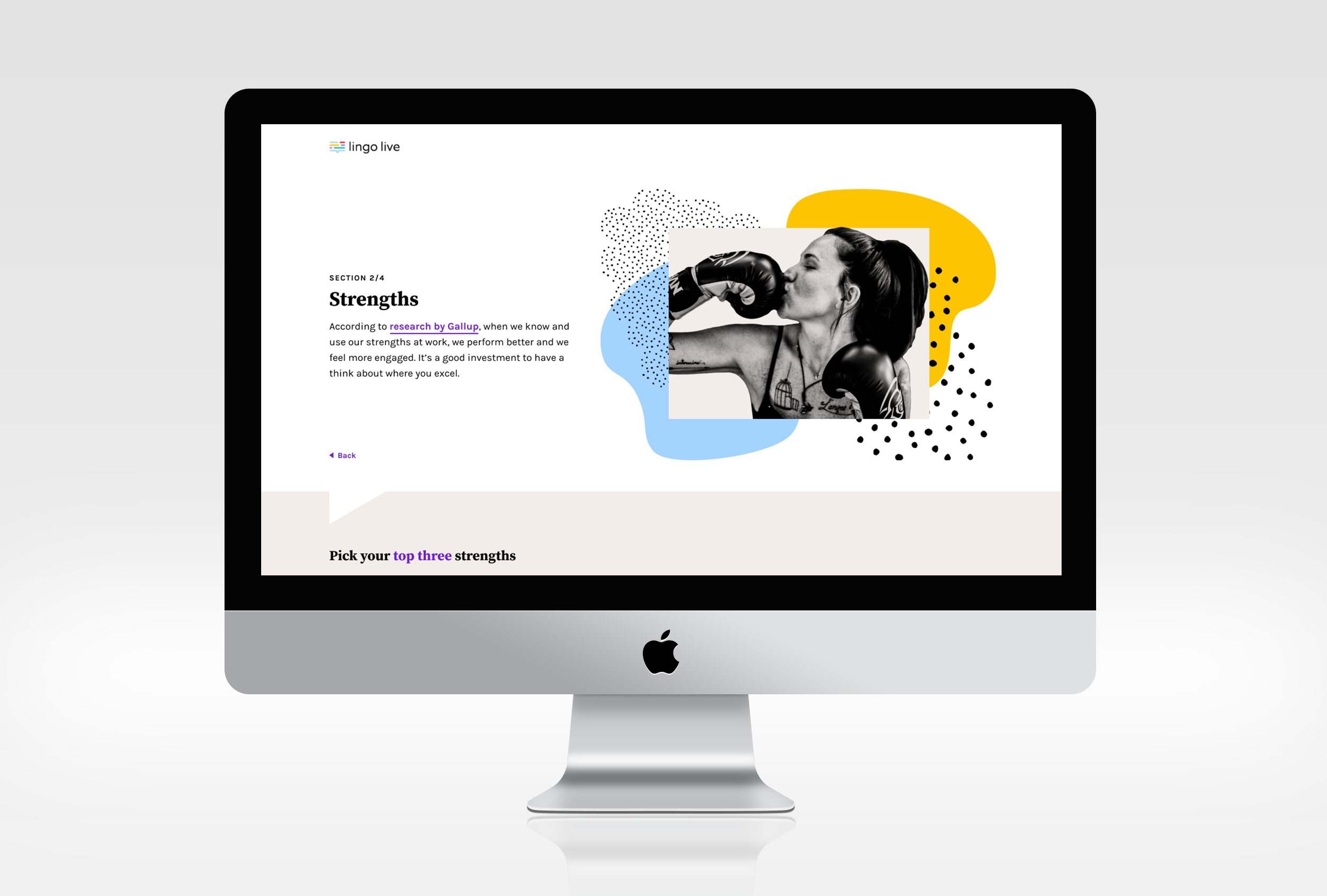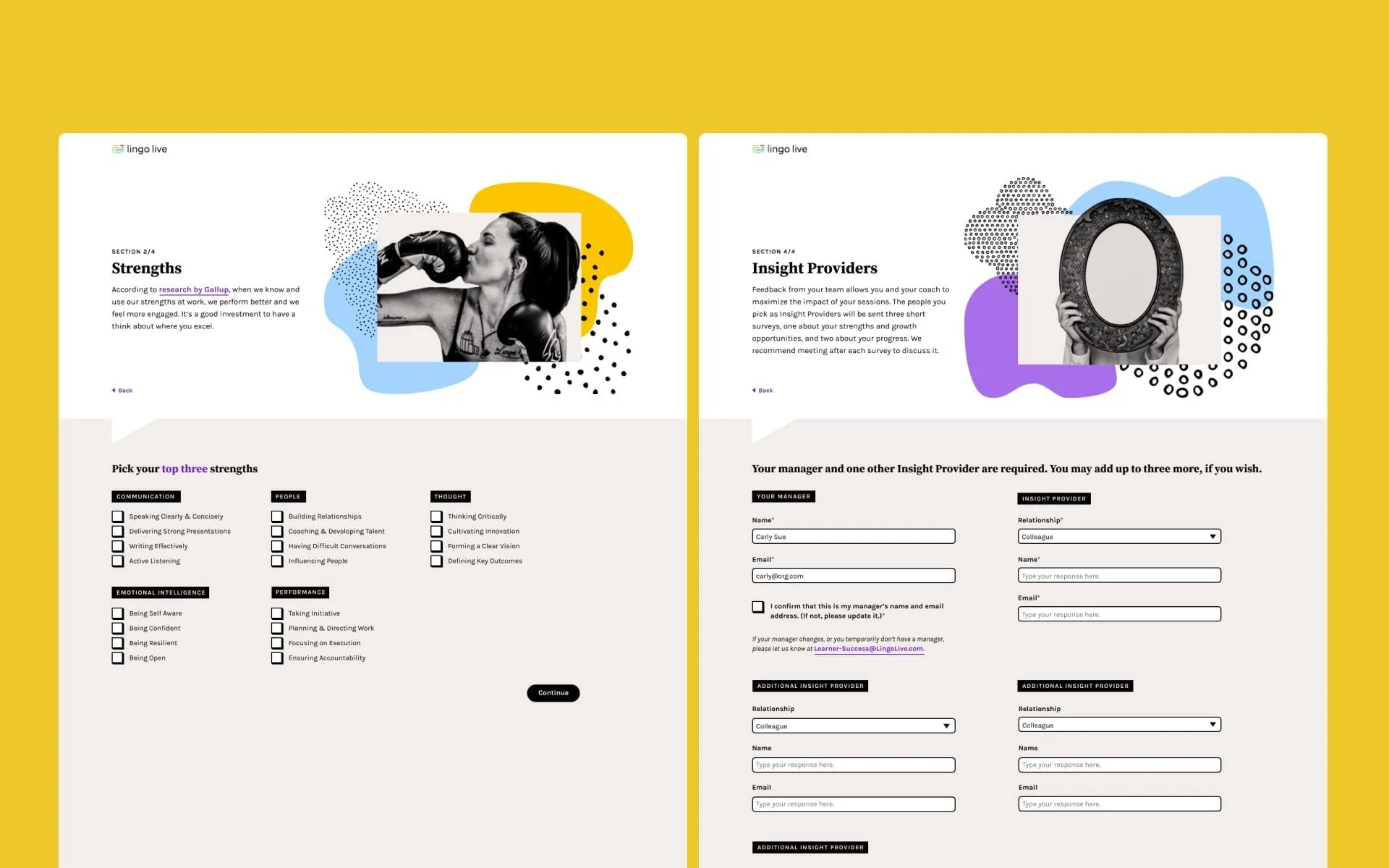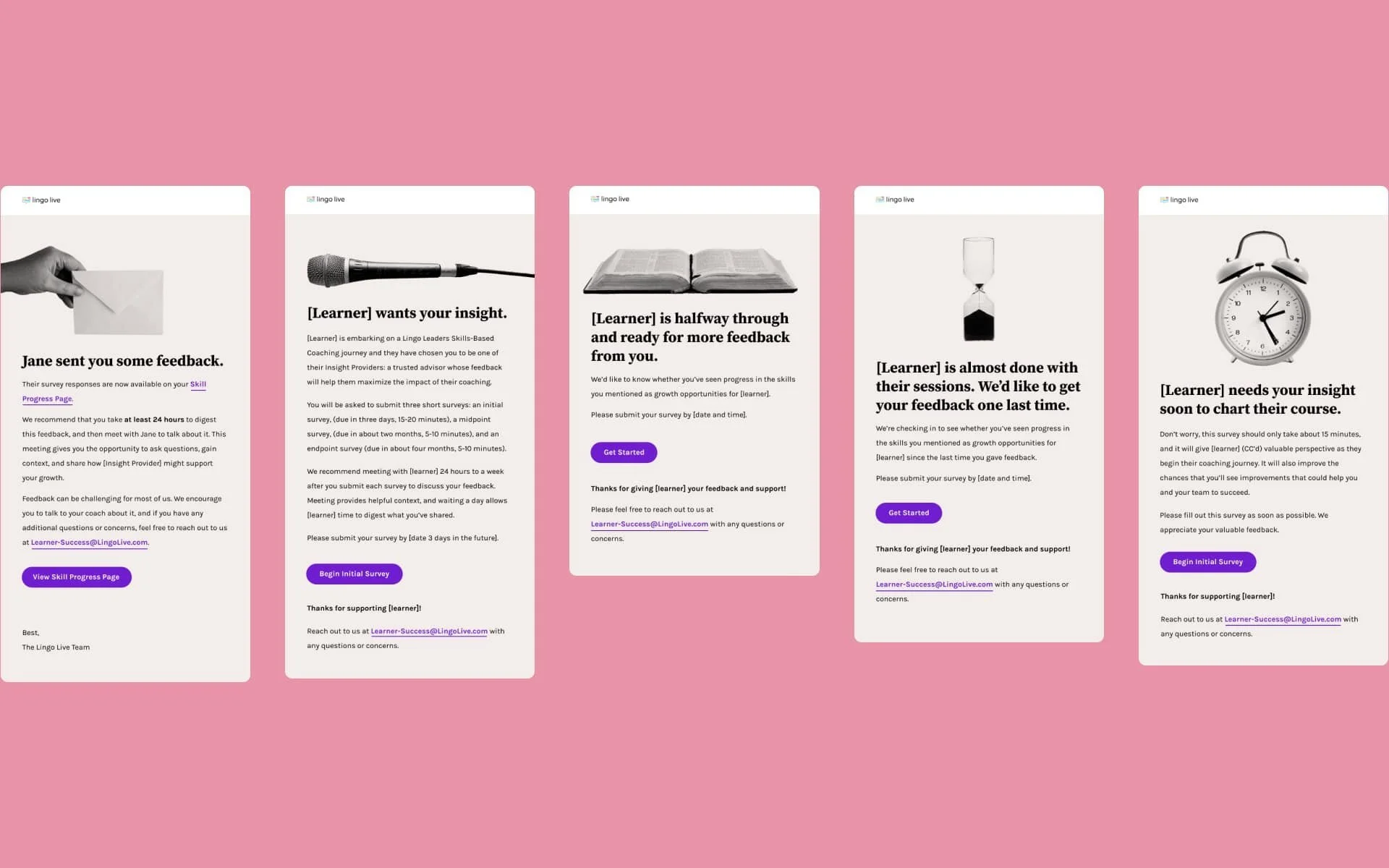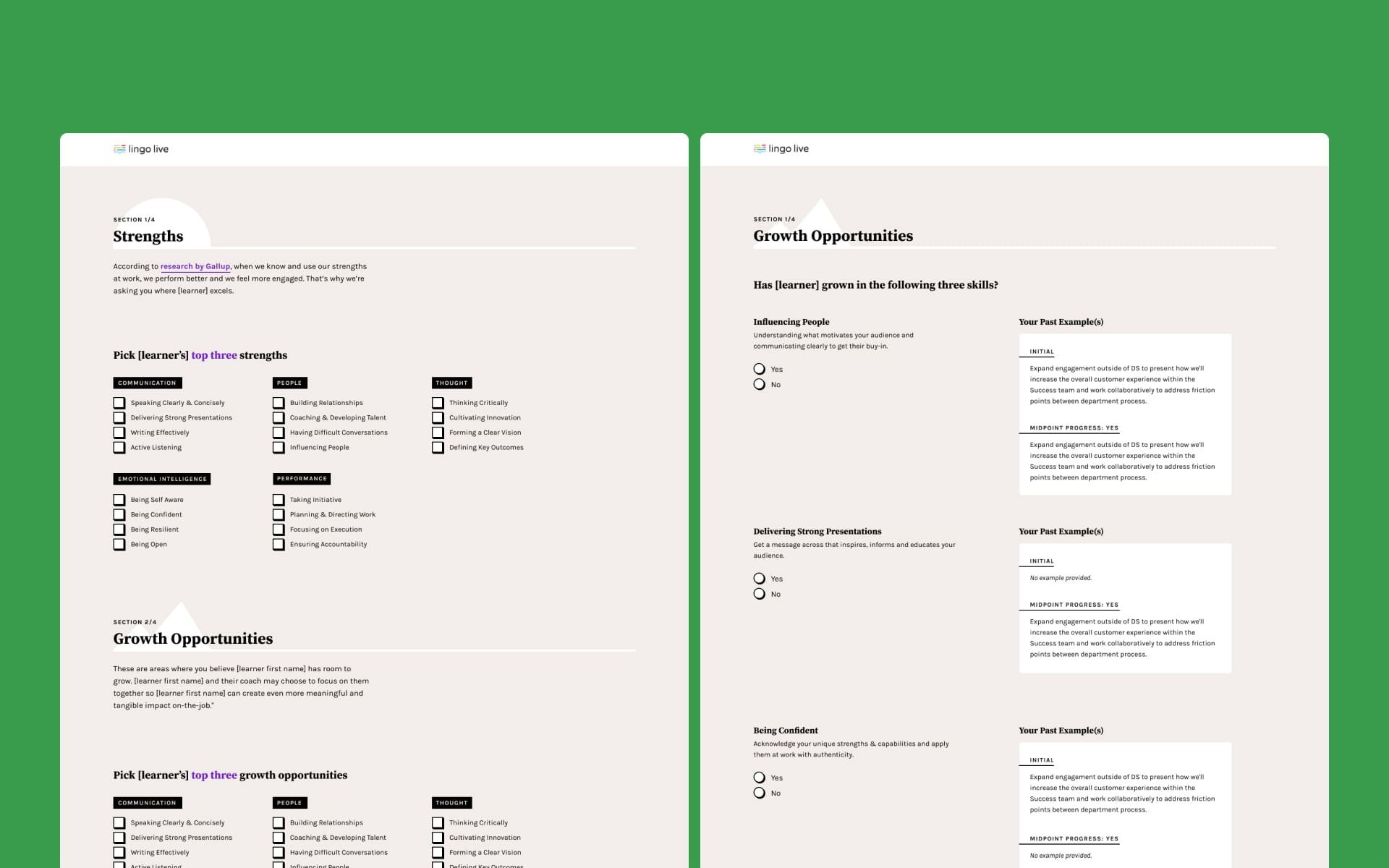Lingo Live App Feature
I designed a series of surveys and emails, and a Learner Profile Page to collect and share self-reported and 360 progress feedback to both provide transparency for clients and remind the learner of how far they’ve come and what they might work on next.
My role
Research, Product design
Team
Product Manager
3 Engineers
The Background
Lingo Live leadership coachees found their coaching experiences transformational, but it was hard to prove on-the-job impact through self-reporting alone.
Lingo Live is a B2B online leadership coaching provider. A typical client is a Learning & Development leader who wants to provide coaching to employees to improve business results. In order to continue or expand the program, the client needs to be able to demonstrate coachee progress to their leadership team. One of the most persuasive ways to do that to show that a coachee’s team members observed improved performance through 360 feedback from team members.
The Skill Alignment feature is a set of in-app surveys, emails, and a prolfile page, that capture each coachee’s top three focus skills and measure progress in them based on coachee and 360 feedback survey results.
The Business Problem
Lingo Live was losing business because clients couldn’t prove to their leadership teams that coaching led to improved job performance.
Lingo Live clients wanted make sure their employees were using coaching to develop skills that were important for their teams and the business as well as their own personal development and that those improved skills were showing up on the job.
Project Outcomes
69% increase in end-user activity in the first 14 days
44% increase in end users completing a session in the first 30 days
44% increase in the percentage of surveys completed
User Research
Clients were keen to see 360 feedback in order to improve learner-manager alignment and better measure progress.
I interviewed seven prospects and former customers who closely matched our Ideal Customer Profile and five coachees who had recently participated in a pilot program to better understand their program and platform needs.
Key Findings
“Progress” is too ambiguous. Clients wanted to know what we meant by progress. Surveying learners and team members about “progress” in general was not specific enough.
Missed opportunity for manager alignment. Clients wanted coachees to get manager input before the program to encourage alignment with team and business goals.
Before-and-after data to show change. Clients didn’t only want to know whether coachees had made progress, they wanted to know how much. They suggested proficiency scales.
Avoid survey fatigue. Clients think program surveys are appropriate, but should be minimal because they already run many surveys of their own.
Project Goals
We set to prototype experiences that would curate workshops based on learners’ personal and team needs so the value of the commitment was clear.
I prototyped a different solution with each of the three Learning Experience Designers on our team. Each one focused on one of the goals below.
Goals
Specify what progress means. Whether we implemented a proficiency scale or simply described what kind of progress we were looking for, we needed to get more specific.
Invite the manager in. We made the learner’s manager a required member of their feedback team and to recommend that the meet to discuss feedback regularly.
Survey everyone throughout the program. We needed to ask before, during and after the program so we had a baseline for comparison, and an opportunity to intervene.
Keep the surveys short and sweet. We just needed a quick pulse check on whether there was observable progress, and any examples that came to mind.
Solution 1: Learner Onboarding Survey
Guiding learners through picking focus skills and recruiting a feedback team
This is the onboarding survey the learner completes in order to register on the platform.
The problem
“Progress” is too ambiguous. Clients wanted to know what we meant by progress. Surveying learners and team members about “progress” in general was not specific enough.
Missed opportunity for manager alignment. Clients wanted coachees to get manager input before the program to encourage alignment with team and business goals.
The goal
Specify what progress means. Whether we implemented a proficiency scale or simply described what kind of progress we were looking for, we needed to get more specific.
Invite the manager in. We made the learner’s manager a required member of their feedback team and to recommend that the meet to discuss feedback regularly.
The solution
Pick focus skills to track. We clarified the ambiguity of measuring coaching progress by asking the learner to pick three skills to focus on from our Skill Catalog. That way we could ask the learner and their feedback team about those skills specifically, and provide descriptions, instead of asking about unspecified progress.
Recruit a feedback team. The last step of the onboarding survey asks the learner to provide the names and emails of their feedback team. Their manager is required to be a part of the team—clients overwhelming wanted managers involved and our research indicated in improved results. Additional colleagues and direct reports are optional.
“It is so helpful for the coachee to share what they want to work on, commit to that, and modify their behavior so that when we go back in 3 or 6 months the coachee says, ‘Yes, I’ve seen a marked difference.’ It persuades our execs of the value of this program.”
Laura, Mattel, L&D Client
Solution 2: Email Campaign
Notifying learners and their feedback teams about giving and receiving progress feedback
Learners and their feedback team members received emails notifying them when it was time to complete a progress survey and the learner also received email notifications whenever a feedback team member submitted their survey.
The problem
Missed opportunity for manager alignment. Clients wanted coachees to get manager input before the program to encourage alignment with team and business goals.
The goal
Invite the manager in. We made the learner’s manager a required member of their feedback team and to recommend that the meet to discuss feedback regularly.
The solution
Timely reminders—off the platform. We learned that even learners spent minimal time on the digital platform, so we knew we needed another channel to notify and remind them and their feedback teams about surveys. Email was a natural fit. We took advantage of the format to inject a bit of our playful brand personality. We also provided our success team email in case learners were struggling with something and needed help.
Solution 3: Progress Tracking Surveys
Collect enough progress data to keep tabs on it without inducing survey fatigue
A learner checks their progress toward achieving various Skill Set badges on their dashboard, and checks their organization’s page to see who has LifeLabs’ Learning questions or successes that they can respond to.
The problem
Survey everyone throughout the program. We needed to ask before, during and after the program so we had a baseline for comparison, and an opportunity to intervene.
Avoid survey fatigue. Clients think program surveys are appropriate, but should be minimal because they already run many surveys of their own.
The goal
Survey everyone throughout the program. We needed to ask before, during and after the program so we had a baseline for comparison, and an opportunity to intervene.
Invite the manager in. We made the learner’s manager a required member of their feedback team and to recommend that the meet to discuss feedback regularly.
The solution
Show an arc. We created progress surveys that went out at the beginning, middle and end of the program so there was a baseline for comparison (the original impressions of the learners ability in the three focus skills), a read at the mid-point which provided an opportunity for course correction, and a final survey to show the total progress over the course of the experience.
Keep it simple. Ask for examples. These three surveys are only three questions long. In the first one, we ask for impressions of the learner’s ability in the focus skills and we ask for examples. For the following surveys, we ask if progress has been observed and ask for examples. We considered complex proficiency rating systems, but in the end decided that a simple yes or no to progress was helpful on its own, and specific examples were the simplest and most clear ways of demonstrating the magnitude of the change and impact.
“Getting feedback at the midpoint is huge because we can see if what we are doing is working and adjust accordingly. Directly involving the feedback team creates more accountability and focus.”
Keith Turner, Lingo Live Coach
Solution 3: Learner Profile Page
Giving the learner a home for all their and feedback for self-reflection and as a conversation starter
A learner checks their progress toward achieving various Skill Set badges on their dashboard, and checks their organization’s page to see who has LifeLabs’ Learning questions or successes that they can respond to.
The problem
Before-and-after data to show change. Clients didn’t only want to know whether coachees had made progress, they wanted to know how much. They suggested proficiency scales.
Missed opportunity for manager alignment. Clients wanted coachees to get manager input before the program to encourage alignment with team and business goals.
The goal
Survey everyone throughout the program. We needed to ask before, during and after the program so we had a baseline for comparison, and an opportunity to intervene.
Invite the manager in. We made the learner’s manager a required member of their feedback team and to recommend that the meet to discuss feedback regularly.
The solution
Show an arc. Human beings have a negativity bias, so easy to focus on where we still have room to grow, and forget how much progress we’ve made. We created a Learner Profile Page to celebrate the learner’s growth, remind them of it, and prompt reflection about what skills and goals to focus on next.
Sustain a professional development conversation. We wanted to encourage the learner to share their coaching experience with their manager, yes, because L&D Admins wanted learner’s program goals to be aligned with their manager’s team goals, but also because the learner’s manager is a powerful resource for their continued professional development, and if we could provide a window for them into the progress the learner has been making, they could provide them with relevant stretch assignments and continue to nurture their growth after the program is over.
“I really like the new functionality and how the information is delivered to the coachee. In the past, I found it difficult to find review past survey responses to see how I have improved. This information is invaluable in the learning process.”
Benjamin, Lingo Live Learner





